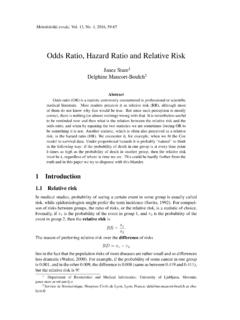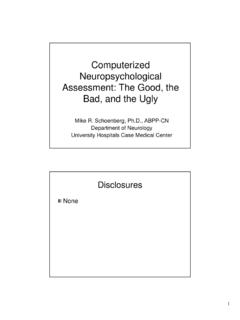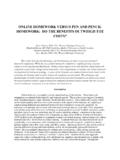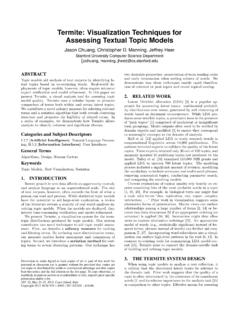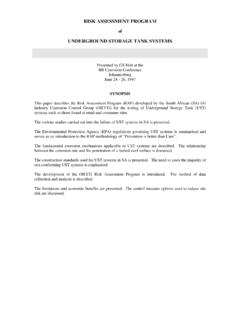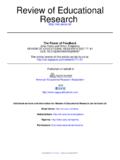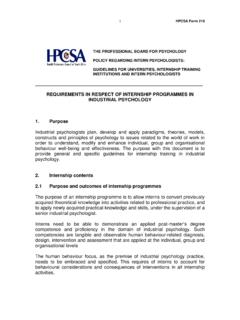Transcription of Open-ended vs. Close-ended Questions in Web …
1 Developments in Applied Statistics Anu ka Ferligoj and Andrej Mrvar (Editors) Metodolo ki zvezki, 19, Ljubljana: FDV, 2003 Open-ended vs. Close-ended Questions in Web Questionnaires Ur a Reja, Katja Lozar Manfreda, Valentina Hlebec, and Vasja Vehovar1 Abstract Two quite different reasons for using Open-ended as opposed to Close-ended Questions can be distinguished. One is to discover the responses that individuals give spontaneously; the other is to avoid the bias that may result from suggesting responses to individuals. However, Open-ended Questions also have disadvantages in comparison to Close-ended , such as the need for extensive coding and larger item non-response. While this issue has already been well researched for traditional survey questionnaires, not much research has been devoted to it in recently used Web questionnaires.
2 We therefore examine the differences between the Open-ended and the Close-ended question form in Web questionnaires by means of experiments within the large-scale RIS 2001 Web survey. The question What is the most important, critical problem the Internet is facing today? was asked in an Open-ended and two Close-ended question forms in a split-ballot experiment. The results show that there were differences between question forms in univariate distributions, though no significant differences were found in the ranking of values. Close-ended Questions in general yield higher percentages than Open-ended question for answers that are identical in both question forms. It seems that respondents restricted themselves with apparent ease to the alternatives offered on the Close-ended forms, whereas on the Open-ended question they produced a much more diverse set of answers.
3 In addition, our results suggest that Open-ended Questions produce more missing data than Close-ended . Moreover, there were more inadequate answers for Open-ended question . This suggests that Open-ended Questions should be more explicit in their wording (at least for Web surveys, as a self administered mode of data collection) than Close-ended Questions , which are more specified with given response alternatives. 1 Faculty of Social Sciences, University of Ljubljana, Kardeljeva plo ad 5, 1000 Ljubljana, Slovenia. 160 Ur a Reja et al. 1 Introduction As in other survey modes, the questionnaire has an extremely important role in the success of a Web survey. It influences several aspects of data quality, varying from non-response, sampling, and coverage errors, to measurement errors.
4 Badly worded Questions or poor visual design may deter respondents from carefully answering individual Questions , therefore increasing item non-response. An exaggerated use of multimedia and other advances in Web questionnaire technology (for example, quality-check reminders) may result in long waits for downloading or put additional burden on respondents which could, in turn, cause frustrations that result in respondents abandoning the questionnaire prematurely, therefore increasing partial non-response (see for example, Comley, 2000: 331; Dillman et al., 1998a; Lozar Manfreda et al., 2002). In addition, inadequate design ( uninteresting, looking too complicated, etc.) may also prevent respondents from starting to answer the questionnaire at all, therefore increasing unit non-response.
5 Some technical aspects of questionnaire design may also prevent certain respondents from accessing the Web site with the survey questionnaire , therefore increasing coverage error2(Andrews and Feinberg, 1999; Brennan et al., 1999: 86; Dillman et al., 1998a; Nichols and Sedivi, 1998). This may occur owing to problems with the compatibility of the equipment used by respondents, their graphics resolutions and/or required download time. This happens especially if extraneous features, such as multimedia, are included in the questionnaire . In addition, inadequate questionnaire design may increase instrument error as a type of measurement error. This occurs when, because of inappropriate questionnaire design (due to question wording or visual representation), the respondent cannot provide answers in the appropriate manner (see for example, Couper, 2001b; Lozar Manfreda et al.)
6 , 2002; Reips, 2000b). Because of the self-administration, questionnaire design in Web surveys may be even more important for data quality than it is in other survey modes. The questionnaire is one of the most important features (in addition to invitations to the survey and the questionnaire introductory page) that the researcher has for communicating with respondents. There is no interviewer to intervene in the case of any misunderstanding in the communication exchange between the researcher and the respondent. Therefore, several problems can occur. For example, severe selection bias may be present: respondents may not be motivated enough to complete a whole questionnaire without interaction with another person, and thus 2 Reasons for coverage error in Web surveys are, of course, much broader.
7 In particular the problem of not having access to the Internet is the main reason for non-coverage in Web surveys. However, here we concentrate on the coverage error that occurs because of questionnaire design. In this case, the questionnaire design itself may p revent respondents who otherwise have access to the Internet - from accessing the Web page with a particular survey questionnaire . Open-ended vs. Close-ended Questions in Web Questionnaires 161 may abandon the questionnaire . In addition, probing is not possible; this may be particularly problematic for Questions with multiple response format and for Open-ended Questions . Because of the unobserved process of data collection, it is also not known whether respondents understand and follow the given instructions.
8 The Web questionnaire is therefore the only tool that the researcher has available, and its careful design is very important for obtaining survey data of the desired quality. Besides self-administration, there are also several other reasons for Web questionnaires tendency to produce larger survey errors than other survey modes. For example, Web questionnaires are often designed by people who lack methodological skills (Couper, 2000: 465). This results in bad questionnaire design from the visual (see for example Bowker, 1999) or verbal (see for example Gr f, 2001: 74-75) points of view. In addition, Internet users tend to read more quickly, to be more impatient and more fastidious than off-line readers (Internet Rogator, 1998); they scan written material on the site with their fingers on the mouse ready to click on through to the next thing (Bauman et al.)
9 , 2000). This suggests that mistakes in questionnaire design, which would be considered of minor importance in other survey modes, may be very significant in Web surveys. Based on the importance of questionnaire design in Web surveys, this paper deals with one of the techniques used for designing Web survey questionnaires, namely the differences between Open-ended and Close-ended question forms. This may give us insight into the validity of individual Questions and offer suggestions for response alternatives in the Close-ended question , if the survey is to be repeated. This technique will be outlined and its specifics for Web questionnaire design will be discussed. Additionally, an empirical example will be presented and its benefits for the design will be discussed.
10 2 Open-ended vs. Close-ended Questions Open-ended and Close-ended Questions differ in several characteristics, especially as regards the role of respondents when answering such Questions . Close-ended Questions limit the respondent to the set of alternatives being offered, while Open-ended Questions allow the respondent to express an opinion without being influenced by the researcher (Foddy, 1993: 127). This has several consequences for the quality of survey data. The advantages of the Open-ended Questions include the possibility of discovering the responses that individuals give spontaneously, and thus avoiding the bias that may result from suggesting responses to individuals, a bias which may occur in the case of Close-ended Questions .

